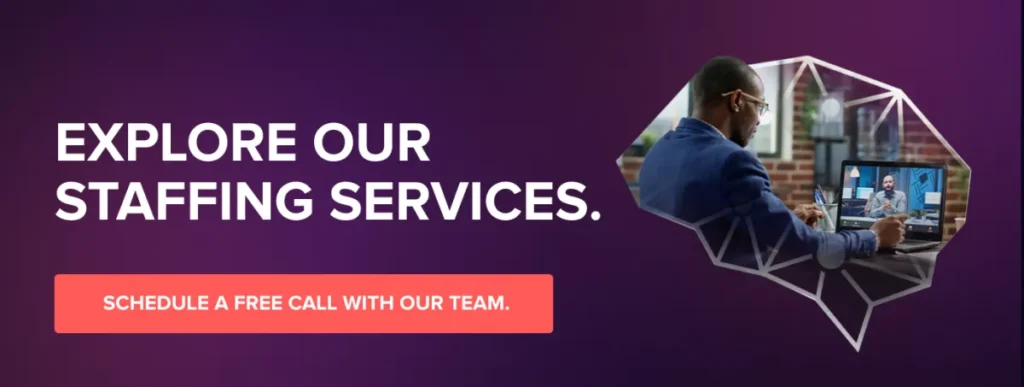Introduction

In the dynamic world of corporate development, the role of a Learning and Development (L&D) Manager is becoming increasingly pivotal. As the architect of educational strategies and the catalyst for professional growth, an L&D Manager combines strategic vision with practical skills to shape the future of their organizations. Their role is multifaceted, involving the assessment of organizational needs, the design of training programs, and the implementation of learning strategies that align with corporate goals.
For employers focused on sourcing the most effective job description template for a Learning and Development Manager, we offer a comprehensive resource that serves as an ideal foundation for drafting your own specifications. This document is available for direct download and encapsulates the fundamental principles and best practices of C9Staff’s renowned hiring methodology. It’s designed to streamline your hiring process and ensure you attract top-tier candidates. To access this valuable template and enhance your recruitment strategy, simply visit our resource page and download the complimentary job description for a Learning and Development Manager.
Learning and Development Manager Job Description TEmplate

The importance of L&D Managers cannot be overstated. They are instrumental in driving organizational growth through the development of human capital. Effective learning strategies curated by these professionals not only enhance employee skills but also foster an environment of continuous improvement and innovation. This, in turn, leads to significant enhancements in productivity and competitiveness. For individuals, the role facilitated by L&D Managers is equally transformative, offering pathways for career advancement and personal development that were once elusive.
This article is structured to provide an in-depth look at this crucial position. For employers, it offers insights into crafting the perfect job description, identifying the right candidate, and understanding the latest trends affecting this role. Job seekers will find valuable information on the skills and qualifications necessary to excel, along with tips for highlighting their expertise during the application process. Each section is designed not only to inform but also to empower you with actionable insights, ensuring that you have the tools needed to either refine your hiring strategies or advance your career in this vital field.
As we explore deeper into each aspect of the Learning and Development Manager’s role, I invite you to engage with this comprehensive exploration. Whether you are looking to hire an L&D Manager or aspiring to become one, this guide promises to equip you with the knowledge and strategies needed for success in this influential role.
Unlocking Potential: The Impact of Learning & Development in the Workplace
What is a Learning and Development Manager?

In today’s rapidly evolving corporate landscape, the role of the Learning and Development (L&D) Manager has never been more critical. These professionals stand at the crossroads of strategy and execution, masterfully steering their organizations towards growth through comprehensive learning initiatives. As strategists, L&D Managers identify skills gaps and align learning objectives with overarching business goals. As implementers, they meticulously execute these strategies, transforming theoretical business needs into tangible educational programs that drive corporate success.
Core Responsibilities of an L&D Manager
The primary responsibilities of an L&D Manager encompass a broad spectrum of activities designed to cultivate an organization’s intellectual capital. These include:
Development of Training Programs: Crafting customized training modules tailored to enhance specific skills and competencies within the workforce.
Implementation of Learning Strategies: Deploying innovative learning techniques such as microlearning, e-learning, and instructor-led training to meet diverse learning preferences and organizational needs.
Management of Educational Resources: Overseeing the allocation and optimization of resources, including budgets, technologies, and human capital, to support ongoing educational endeavors.
Daily Activities
On a day-to-day basis, L&D Managers engage in a variety of tasks that bridge the gap between strategic planning and operational execution:
Strategic Planning Sessions: Collaborating with other department heads to ensure learning and development strategies are perfectly aligned with business objectives.
Hands-On Training Execution: Leading training sessions, overseeing the rollout of new e-learning platforms, and gathering feedback to refine learning approaches continuously.
Performance Metrics Analysis: Reviewing data on employee performance and program effectiveness to adjust strategies and improve outcomes continually.
Impact on Organizational Success and Employee Satisfaction
The impact of an effective L&D Manager on an organization can be profound and multifaceted. Here are a few key outcomes:
Improved Performance Metrics: Organizations with strong L&D leadership often see marked improvements in productivity and efficiency, as employees are better equipped with the skills needed to excel in their roles.
Enhanced Employee Engagement: Well-crafted learning programs contribute to higher levels of employee engagement, as staff appreciate the investment in their personal and professional growth.
Reduced Turnover Rates: When employees feel valued and see clear paths for advancement, turnover rates typically decrease, stabilizing the workforce and reducing recruitment costs.
The role of an L&D Manager is instrumental in fostering an environment where continuous improvement and innovation are not just encouraged but embedded into the very fabric of the organization. As you, the reader, delve deeper into this exploration, visualize the transformative potential of robust learning and development practices in your professional setting. Whether you are an aspiring L&D Manager or a business leader looking to enhance your team’s capabilities, the insights garnered here could be the catalyst for significant positive change within your organization.
Crafting the Perfect Job Description

Creating an effective job description for a Learning and Development (L&D) Manager is both an art and a science. It requires a precise blend of detailed information and strategic presentation to attract the best candidates. This section will guide you through the essential components of a job description and how to tailor it to both align with your organization’s needs and appeal to high-quality candidates.
Key Elements of a Job Description
A comprehensive job description for an L&D Manager should include the following key elements:
Specific Responsibilities: Clearly outline what is expected from the L&D Manager, including developing training programs, overseeing learning initiatives, and measuring their effectiveness.
Required Skills: Detail the skills necessary for the role, such as strong leadership abilities, proficiency in designing and implementing effective training programs, and expertise in performance management.
Educational Prerequisites: Specify the educational background required, typically a degree in Human Resources, Education, Organizational Development, or a related field.
Desired Personal Attributes: Emphasize attributes like adaptability, problem-solving skills, and the ability to inspire and motivate others.
Tailoring Job Descriptions
To attract the best candidates, tailor the job description with the following tips:
Use Clear, Inclusive Language: Ensure the language is straightforward and free of industry jargon to make the job accessible to all potential applicants.
Highlight Career Progression Opportunities: Show how the role contributes to personal and professional growth within the company.
Align with Strategic Goals: Demonstrate how the L&D Manager’s role aligns with the organization’s strategic objectives, emphasizing the impact of this role on the company’s success.
Incorporate Company Culture and Values: Describe the company culture and how it supports and enhances the work of an L&D Manager, which helps attract candidates who are a good cultural fit.
Compliance with Industry Standards
Ensuring the job description meets industry standards is crucial:
Legal Requirements: Make sure the description complies with employment law, such as equal opportunity employment and job safety regulations.
Professional Standards: Align the job requirements with professional standards to ensure the role is recognized and respected within the industry.
Ethical Guidelines: Reflect high ethical standards in the description to attract candidates who value integrity and responsibility.
For employers focused on sourcing the most effective job description template for a Learning and Development Manager, we offer a comprehensive resource that serves as an ideal foundation for drafting your own specifications. This document is available for direct download and encapsulates the fundamental principles and best practices of C9Staff’s renowned hiring methodology. It’s designed to streamline your hiring process and ensure you attract top-tier candidates. To access this valuable template and enhance your recruitment strategy, simply visit our resource page and download the complimentary job description for a Learning and Development Manager.
Learning and Development Manager Job Description TEmplate

Required Skills and Qualifications

To excel as a Learning and Development (L&D) Manager, a comprehensive set of skills, qualifications, and personal traits is essential. These requirements are not just boxes to be checked but are critical to fostering effective learning environments and driving organizational success. Let’s explore these key components that make an L&D Manager truly effective.
Essential Skills for an L&D Manager
Strategic Planning: L&D Managers must be able to design long-term strategies for employee development that align with the company’s goals. This skill is crucial for ensuring that training programs contribute directly to organizational growth and help in achieving business objectives.
Leadership: Effective leadership is necessary to inspire and motivate both the learning team and the wider employee base. This includes managing a diverse team of trainers and specialists and leading by example.
Communication: Clear communication is vital for articulating learning objectives, delivering training sessions, and ensuring that all stakeholders are aligned with the learning goals. This skill also helps in effectively gathering feedback to improve future programs.
Technical Skills: Proficiency in learning management systems (LMS) and other educational technologies is essential for designing, implementing, and monitoring training programs. These technical skills help in delivering content in more engaging and effective ways.
Educational and Professional Qualifications
Educational Background: Typically, an L&D Manager will have a degree in Education, Psychology, Business Administration, Human Resources, or a related field. These disciplines provide the theoretical knowledge and analytical skills necessary to design effective learning programs.
Certifications and Continuing Education: Certifications such as ATD Certified Professional in Learning and Performance (CPLP) or SHRM Certified Professional can greatly enhance an L&D Manager’s credentials. Continuing education through workshops, seminars, and courses in specific training methodologies or new technologies in education is also beneficial.
Desired Personal Traits
Empathy: This trait allows L&D Managers to understand and address the diverse needs of learners, creating more inclusive and effective training environments.
Adaptability: The ability to adapt strategies to meet changing organizational needs or to incorporate new learning technologies is crucial in keeping programs relevant and effective.
Passion for Learning: A genuine enthusiasm for personal and professional growth not only fosters a positive learning culture within the organization but also encourages continuous improvement in training practices.
Impact on Career and Organizational Success
Possessing these skills, qualifications, and traits enables L&D Managers to lead successful programs that significantly contribute to the strategic objectives of their organizations and enhance workplace culture. The direct impact of a skilled L&D Manager includes improved employee performance, higher engagement and satisfaction levels, and ultimately, reduced turnover and higher retention rates.
As you reflect on these requirements, whether you’re looking to hire an L&D Manager or aspire to one day hold this position yourself, consider these benchmarks as essential guidelines for fostering a successful career and driving meaningful organizational change. Engage with these insights to not just fulfill the role but to excel in shaping the learning and development landscape of your organization.
Hiring and Interviewing for Success

Hiring the right Learning and Development (L&D) Manager is a pivotal decision that can significantly influence the effectiveness of your organization’s learning initiatives and overall growth. Identifying the ideal candidate requires a deep understanding of the role’s required skills, qualifications, and personal traits, as discussed in the previous sections. Aligning these elements with candidate profiles during the hiring process ensures that you select an individual who not only possesses the necessary expertise but also fits well within your organizational culture.
Identifying the Right Candidate
Start by ensuring that the candidate’s professional background aligns with the detailed job description. Look for evidence of both hard skills, like proficiency in learning management systems, and soft skills, such as leadership and communication. It’s crucial to assess how well candidates can integrate their skills into your specific workplace environment. This alignment is critical for selecting someone who can effectively lead your learning initiatives and drive organizational success.
Effective Interview Questions
To thoroughly evaluate candidates, consider these interview questions designed to uncover essential competencies:
Strategic Planning: “Can you describe a time when you had to develop a long-term learning strategy? What was your approach, and what were the outcomes?”
Leadership Experience: “Tell us about a situation where you had to lead a team through a challenging project. How did you manage the team dynamics?”
Adaptability: “How have you adapted your training programs in response to changes within a previous organization?”
Incorporate behavioral interview techniques and scenario-based questions to see how candidates handle specific situations, providing insights into their real-world problem-solving and adaptability.
Presenting Your Organization
During the interview, it’s vital to present your organization as an attractive place to work. Emphasize aspects such as:
Company Culture: Share how your company values and practices support a productive and positive work environment.
Growth Opportunities: Highlight how the role of an L&D Manager is critical for career advancement within the company.
Learning and Development Initiatives: Discuss ongoing and future projects that showcase the company’s commitment to learning and development.
Transparency about these factors not only attracts candidates who are a good fit but also those who are likely to be genuinely motivated and engaged by the role and the organizational environment.
For Candidates: How to Shine

As a candidate aspiring to become a Learning and Development (L&D) Manager, your journey begins long before you step into the interview room. It starts with a meticulously crafted resume and a strategically tailored application that sets you apart from the competition. This section provides you with actionable strategies to not only catch the eye of your future employers but also excel in this pivotal role.
Preparing Your Resume and Application
To stand out, your resume should highlight relevant experiences and specific achievements that align with the skills and traits required for an L&D Manager. For example, if the job description emphasizes strategic planning, include instances where you successfully developed and implemented learning programs that yielded measurable improvements in business outcomes. Furthermore, certifications such as ATD or CIPD should be prominently featured if they are relevant to the role.
Tailoring your application involves more than just listing qualifications—it means aligning your stated skills and past experiences with the strategic goals and culture of the prospective employer. Research the company’s values and current L&D initiatives, and reflect this understanding in your cover letter and resume. This alignment shows that you are not only a fit for the role but also a potential catalyst for the company’s future growth.
Demonstrating Value in Interviews
The interview is your opportunity to demonstrate how your background, skills, and vision align with the needs of the organization. Prepare by researching the company thoroughly, understanding its challenges, and being ready to discuss concrete ways you can make a positive impact. For instance, if the company is looking to expand its digital learning offerings, discuss your experience with e-learning platforms and mobile training solutions.
You should also be prepared to answer and ask questions that showcase your strategic thinking and leadership capabilities. Questions you might face include:
- “Describe a time when you had to overcome resistance to a new training program. How did you handle it?”
- “How do you measure the success of a training initiative?”
Moreover, effectively communicate your enthusiasm for the role and the company, highlighting your commitment to fostering an innovative learning environment.
Strategies for Ongoing Professional Development
To truly excel as an L&D Manager, commit to continuous professional development. Engage in relevant courses, workshops, and certifications that not only enhance your skills but also keep you abreast of the latest trends in corporate training and development. Networking with other L&D professionals and participating in industry forums can provide insights into best practices and emerging technologies.
Candidates eager to supercharge their careers and find their dream job are encouraged to explore how C9Staff can assist in this exciting journey. By clicking the link below, you can submit your resume to our talent acquisition department. If your qualifications align with our client requirements, we will contact you to discuss potential opportunities that match your skills and aspirations. This is your chance to connect with top employers and take a significant step forward in your professional life. Don’t miss out—submit your resume today and let us help you find the perfect fit!

Trends and Future Outlook in Learning and Development

The landscape of the Learning and Development (L&D) profession is rapidly evolving, influenced by technological advancements and changing workforce dynamics. As we look to the future, understanding these trends is crucial for L&D Managers aiming to maintain their relevance and effectiveness.
Current Trends Shaping L&D
Several key trends are currently reshaping the role of L&D Managers:
Remote Learning Platforms: With the rise of remote work, there is an increasing demand for online learning platforms that can reach employees globally and asynchronously.
Personalized Learning Experiences: Tailoring learning experiences to individual needs is becoming more feasible and expected, thanks to advances in learning technologies that allow for greater customization and adaptability.
Data-Driven Training Effectiveness: Organizations are increasingly leveraging data analytics to measure the effectiveness of their training programs, leading to more informed decisions about how to train and develop their workforce.
The Impact of Technology
Technology continues to dramatically influence how learning is approached in organizations:
Artificial Intelligence (AI): AI is being used to personalize learning at scale, providing recommendations based on individual learning styles and progress.
Virtual Reality (VR): VR offers immersive learning experiences that are particularly effective for skills training, such as safety procedures or complex technical tasks.
Advanced Analytics: Sophisticated analytics tools help L&D Managers assess the impact of training programs, fine-tuning them to maximize efficiency and effectiveness.
Future Responsibilities and Skills Requirements
As the field evolves, so too do the responsibilities and skills required of L&D Managers:
Digital Content Creation: The ability to create engaging digital learning content that can be accessed on multiple devices will be crucial.
Data Analysis: Skills in data analysis will be necessary to interpret the vast amounts of data generated by learning management systems.
Strategic Business Alignment: L&D Managers will need to align training programs more closely with business goals, proving the ROI of learning initiatives to upper management.
Employers looking to enhance their recruitment process for a Learning and Development Manager are invited to explore how C9Staff can assist in sourcing, recruiting, hiring, training, managing, and deploying the ideal candidate for your organization. Click the link below to schedule a free exploratory call with one of our account managers today. During this call, we will listen carefully to your needs and offer endorsements of potential candidates at no cost, helping you evaluate the best talent available at competitive prices. This is a valuable opportunity to ensure that your hiring strategy is aligned with your organizational goals and optimized for success.

Conclusion: The Strategic Imperative of Learning and Development Managers

As we have explored throughout this article, the role of Learning and Development (L&D) Managers is both pivotal and transformative, significantly impacting organizational success and individual career trajectories. By delving into the core responsibilities, required skills, and evolving trends, we’ve illuminated how integral these professionals are to fostering an environment of continuous learning and strategic growth.
Synthesis of Key Points
From defining the role’s significance in organizational settings to identifying the skills and qualifications essential for success, each section of this article has provided comprehensive insights into the multifaceted nature of L&D management. We’ve discussed the intricacies of crafting precise and effective job descriptions, outlined strategies for successful hiring and interviewing processes, and offered practical advice for candidates aiming to excel in this dynamic field. Moreover, the discussion on current trends and the impact of technology has highlighted the ever-evolving demands placed on L&D Managers to adapt and innovate continually.
Empowering Employers and Candidates
Employers are encouraged to refine their approach to defining and filling this critical role, ensuring that the job description aligns perfectly with both the strategic needs of the organization and the evolving landscape of L&D. Strategic hiring practices are not just about filling a position but about forging a path to organizational resilience and adaptability.
Similarly, candidates should see their journey as a continuous loop of skill enhancement and strategic alignment with industry needs. The necessity to stay abreast of new learning technologies, methodologies, and strategic imperatives is crucial for those aspiring to lead in L&D roles.
Final Thoughts on the Role’s Evolution and Impact
The role of L&D Managers is increasingly recognized not just as a support function but as a core strategic driver of organizational success. An effectively defined L&D Manager role can significantly enhance not only the growth and development of individual employees but also the overall competitive edge of the enterprise. The dynamic nature of this role requires both current and aspiring L&D Managers to remain adaptable and forward-thinking.
As we look to the future, the intersection of technology, strategy, and human development will continue to shape the responsibilities and skills required of L&D Managers. By embracing these insights, you can foster a culture of continuous improvement and innovation that will not only propel your career forward but also drive your organization to new heights.
Let the insights from this article serve as a catalyst for change in your professional practices and organizational strategies. Whether you are refining your approach to L&D or stepping into an L&D role for the first time, the ability to adapt and innovate remains your most valuable asset in this fast-paced business environment. Embrace these roles and responsibilities to lead the way in transforming your workplace into a learning-powered organization.




